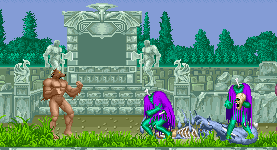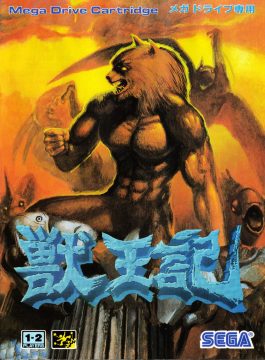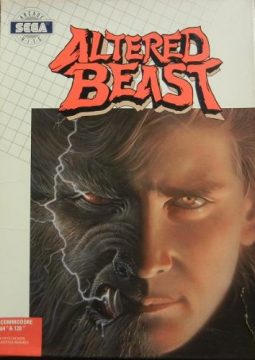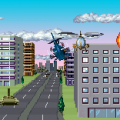Altered Beast – or Jyuuouki (“Chronicles of the Beast King“ in Japan) – is something of a Sega classic, owing mostly to being the original pack-in for the Genesis. Ironically the game is one of their weaker titles, though given the strength of its visuals, it’s easy to see why Sega picked it as a demonstration of the 16-bit console’s power. The game was directed by Makoto Uchida and developed by Team Shinobi, who worked on several other Sega brawler games, including Golden Axe and Alien Storm.
At the beginning of Altered Beast the Greek god Zeus resurrects a fallen warrior and commands him to travel through the underworld – it seems Zeus’ daughter Athena needs rescuing from the evil lord Neff. It’s up to you, and potentially a friend in two-player simultaneous mode, to bash your way through hordes of demons, wolves and monsters.
The game is basically a beat-em-up, though unlike Double Dragon or the later Golden Axe, the action only takes place on a single plane. The screen slowly autoscrolls as enemies lumber forth, whom you can dismantle piece-by-piece by smashing them with your gigantic fists.
Throughout the game you’ll see white wolves, which drop power orbs when killed. When you get one you’ll bulk up slightly, an omniscient voice will announce “POWER UP“, and your punches and kicks will be a bit more powerful. Grab another orb and your muscles will bulge even further, completely tearing your shirt. Get a third and you’re treated to a thoroughly impressive full screen transformation sequence of your human turning into their beast form.
Each of the five levels features a different monster. The Wolf can throw fireballs and execute a cool flaming jump kick. The Dragon can fly, shoot lightning bolts from its mouth, and surround itself with blasts of electricity. The Bear blows petrifying breath and does a crazy spinning jumping roll. The Tiger also has fireballs, as well as a vertical jump kick. In the final level, you turn into the Gold Wolf, which is exactly the same as the first transformation but a little bit more powerful.
One of the most annoying issues is that it’s far too easy to let one of the white wolves slip by, so you lose out on a power-up. The first few times you run into Neff, he’s polite enough to refuse combat if you’re not transformed, so you get to continue with the stage for another cycle. If you mess up too often though, he’ll fight you anyway, which is a recipe for guaranteed death if you’re still a human.
The difficulty is also incredibly high. Enemies approach in droves and attack quickly, and it’s far too easy to get surrounded or bombarded by cheap hits. There’s almost no invincibility time after taking a blow either, which just results in even more damage. Your character is so huge that it’s extremely difficult to dodge attacks during boss battles without getting hit. Unfortunately Altered Beast was originally designed as something of a credit feeder, so when translated to the home consoles, where you’re given limited continues, it just becomes obnoxious.
Altered Beast hasn’t aged quite as well as other Sega properties – it really is all about the visuals. But from a certain mindset, it’s still rather impressive, because the presentation is damn good. Various body parts fly out of the screen when you kill bad guys. Kill a gargoyle, and its body falls to the ground while its wings fly back off into the sky. Kill a Cyclops and its flesh literally falls off. It’s almost humorously grotesque, especially considering there really isn’t any blood or similar effects.
The voices – whether it be the opening cry to “Rise from your grave“ or the nefarious “Welcome to your doom“ spoken before each boss – are iconic. The monster designs are also pretty awesome, especially the early bosses, like the huge demon who rips off his heads and showers his screaming visages down on the player, or the plant-thing which attacks with its innumerable eyes. The Chicken Leg monsters, also known as Chicken Stingers, show up in Golden Axe too. Even though Altered Beast is somewhat lacking as a game, it maintains the joyous excess of 1980s arcade titles which made them so appealing.
Sega also had an incredibly weird meta thing going on with the endings of some of their arcade releases. In Altered Beast, after the game shows you all of the beast forms, it reveals that everyone in the game are merely actors “filming” a “movie”, who all take off their costumes and then share a drink.
The Genesis port is the closest to the arcade version. Some of the minor graphical effects have been toned down, particularly the scaling effects, though parallax scrolling has been added. In general it’s a bit easier, though the music isn’t quite as powerful. The wacky ending is also gone. Otherwise it looks and plays very similarly. There’s also a cheat code that lets you choose which beast to play in each level. This version is found on the Sega Smash Pack Vol. 1 for the Dreamcast, though it suffers from some unfortunate sound degradation. It is also available on the Sega Genesis Collection for the PS2 and PSP, and Sonic’s Ultimate Genesis Collection for the PS3 and Xbox 360, all of which feature near perfect emulation. The arcade version is included as an unlockable bonus. The arcade version is also available on the Wii Virtual Console.
The Sega Master System version isn’t nearly as impressive – it looks okay for the system, but the movement is extremely choppy, and there’s plenty of flickering, resulting in a game that’s practically unplayable. It’s also missing a whole level. Additionally, this and all other console ports suffer because they lack the proper number of buttons, so you need to press up to jump, which is lame.
The PC Engine port has redrawn backgrounds that look significantly worse. Additionally, the controls (especially the jumping) are less responsive than before, making the game considerably more frustrating. A PC Engine CD version was also released early in the system’s life, but is quite a cheap port job. There’s a new intro, featuring a narration over music from the arcade game, as well as improved sound effects. There’s also a difficulty select option to make it slightly easier, but it’s also missing two-player co-op.
The pictures are merely stills from the game, combined with some terribly grainy artwork, and it goes on for several boring minutes. The actual game is exactly the same as the HuCard version – they didn’t even bother to improve the music. It’s also incompatible with the System Card 2.0 and 3.0 requiring the obsolete 1.0 card to function properly. What a wreck.
The Famicom version was produced by Asmik, as opposed to Sunsoft, who handled most of the Sega-to-Famicom ports. The game looks awful, with tiny sprites and ugly colors, but it’s smoother than the Master System version, even though the gameplay is still atrocious. However, Asmik added three whole new levels, with three new beast forms (a lion, a shark and a phoenix), along with some cool new bosses that actually look fairly decent. The ending in this version is even stranger than the arcade version. After the staff roll, the curtain goes down, revealing the screen to be in a movie theater andc the beast and the princess are in the audience? How meta.
There are also a variety of computer ports. The Amiga and Atari ST versions, ported by Software Studios, look and sound the most faithful, although a quarter of the screen is taken up by a status bar, and the graphics are quite dark. It’s also rather choppy and the collision detection is somewhat dodgy. The Commodore 64 version, also ported by the same company and rather similar, starts off incredibly cool, with an excellent replication of the title screen and decent rendition of the main theme. But in-game it’s terrible, with sparse enemies, regrettably awful collision detection, and no music. The PC version, ported by Unlimited Software Inc, suffers from low-color graphics even in VGA mode. The main character moves too quickly compared to the enemies, and the animation is laughable, but in spite of these issues it plays acceptably. The AdLib music conversion is okay, though all of the voices are obviously gone.
All of the above computer ports pale next to the arcade or Genesis ports, but they’re still miles beyond the rest. The Amstrad version looks okay, but it’s impossibly slow, incredibly choppy, and basically unplayable, although the 8-bit chiptune rendition of the music isn’t all that bad. The ZX Spectrum version is essentially identical play-wise, but suffers from the usual brightly miscolored graphics, while the MSX version is a port of the Spectrum version.
The 3DS version is based on the Genesis port. This was chosen over the arcade version since it featured parallax scrolling. It includes a “Random Form” mode which randomly selects a beast when you grab an orb. As a result, you can play as beasts from other levels without using a code.
Although Altered Beast is hardly Sega’s most well known property, it is referenced in the 2012 Disney animated movie Wreck-It Ralph. In the early scene where Ralph meets with other video game villains, Neff is present, in his final rhinoceros form. He does not speak though.
Screenshot Comparisons






















































